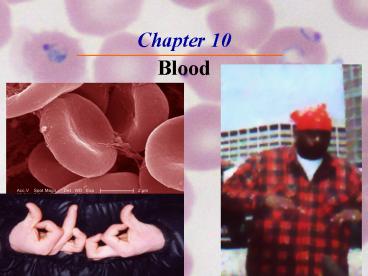Chapter 10 Blood - PowerPoint PPT Presentation
1 / 23
Title:
Chapter 10 Blood
Description:
Chapter 10 Blood Blood Physical Characteristics of Blood Blood Plasma Plasma Proteins Formed Elements Erythrocytes (Red Blood Cells) Hemoglobin Leukocytes (White ... – PowerPoint PPT presentation
Number of Views:305
Avg rating:3.0/5.0
Title: Chapter 10 Blood
1
Chapter 10Blood
2
- Blood
- The only fluid tissue in the human body
- Classified as a connective tissue
- Living cells formed elements
- Non-living matrix plasma
3
- Physical Characteristics of Blood
- Color range
- Oxygen-rich blood is scarlet red
- Oxygen-poor blood is dull red (blue-blood)
- pH must remain between 7.357.45
- Blood temperature is slightly higher than body
temperature
4
- Blood Plasma
- Composed of approximately 90 percent water
- Includes many dissolved substances
- Nutrients
- Salts (metal ions)
- Respiratory gases
- Hormones
- Proteins
- Waste products
5
- Plasma Proteins
- Albumin regulates osmotic pressure
- Clotting proteins help to stem blood loss when
a blood vessel is injured - Antibodies help protect the body from antigens
6
- Formed Elements
- Erythrocytes red blood cells
- Leukocytes white blood cells
- Platelets cell fragments
7
- Erythrocytes (Red Blood Cells)
- The main function is to carry oxygen
- Anatomy of circulating erythrocytes
- Biconcave disks
- Essentially bags of hemoglobin
- Anucleate (no nucleus)
- Contain very few organelles
- Outnumber white blood cells 10001
8
- Hemoglobin
- Iron-containing protein
- Binds strongly, but reversibly, to oxygen
- Each hemoglobin molecule has four oxygen binding
sites
9
- Leukocytes (White Blood Cells)
- Crucial in the bodys defense against disease
- These are complete cells, with a nucleus and
organelles - Able to move into and out of blood vessels
(diapedesis) - Think Osmosis Jones
- Normal levels 4,000-11,000 cells per milliliter
- Abnormal leukocyte levels
- Leukocytosis
- Above 11,000 leukocytes/ml
- Generally indicates an infection
- Leukopenia
- Abnormally low leukocyte level
- Commonly caused by certain drugs
10
- Platelets
- Derived from ruptured multinucleate cells
(megakaryocytes) - Needed for the clotting process
11
- Hematopoiesis
- Blood cell formation
- Occurs in red bone marrow
- All blood cells are derived from a common stem
cell (hemocytoblast)
12
- Fate of Erythrocytes
- Unable to divide, grow, or synthesize proteins
- Wear out in 100 to 120 days
- When worn out, are eliminated by phagocytes in
the spleen or liver - Lost cells are replaced by division of
hemocytoblasts
13
- Control of Erythrocyte Production
- Rate is controlled by a hormone (erythropoietin
or E.P.O.) - Kidneys produce most erythropoietin as a response
to reduced oxygen levels in the blood (training
at altitude)
I didnt do it!
14
- Hemostasis
- Stoppage of blood flow
- Result of a break in a blood vessel
- Hemostasis involves three phases
- Platelet plug formation
- Vascular spasms
- Coagulation
15
Civil War Amputation Kit
16
- Blood Clotting
- Blood usually clots within 3 to 6 minutes
- The clot remains as endothelium regenerates
- The clot is broken down after tissue repair
17
- Undesirable Clotting
- Thrombus
- A clot in an unbroken blood vessel
- Can be deadly in areas like the heart
18
Undesirable Clotting
- Embolus
- A thrombus that breaks away and floats freely in
the bloodstream - Can later clog vessels in critical areas such as
the brain
19
Symptoms
20
- Bleeding Disorders
- Thrombocytopenia
- Platelet deficiency
- Even normal movements can cause bleeding from
small blood vessels that require platelets for
clotting - Hemophilia
- Hereditary bleeding disorder
- Normal clotting factors are missing
21
- Developmental Aspects of Blood
- Sites of blood cell formation
- The fetal liver and spleen are early sites of
blood cell formation - Bone marrow takes over hematopoiesis by the
seventh month - Fetal hemoglobin differs from hemoglobin produced
after birth (oxygen saturation curve)
22
Blood Types Antibodies
23
Deoxygenated Blood































